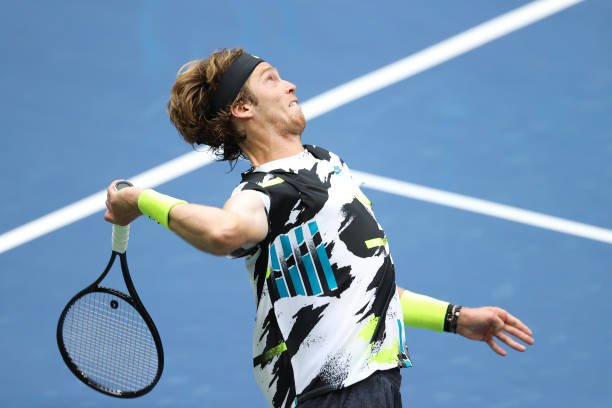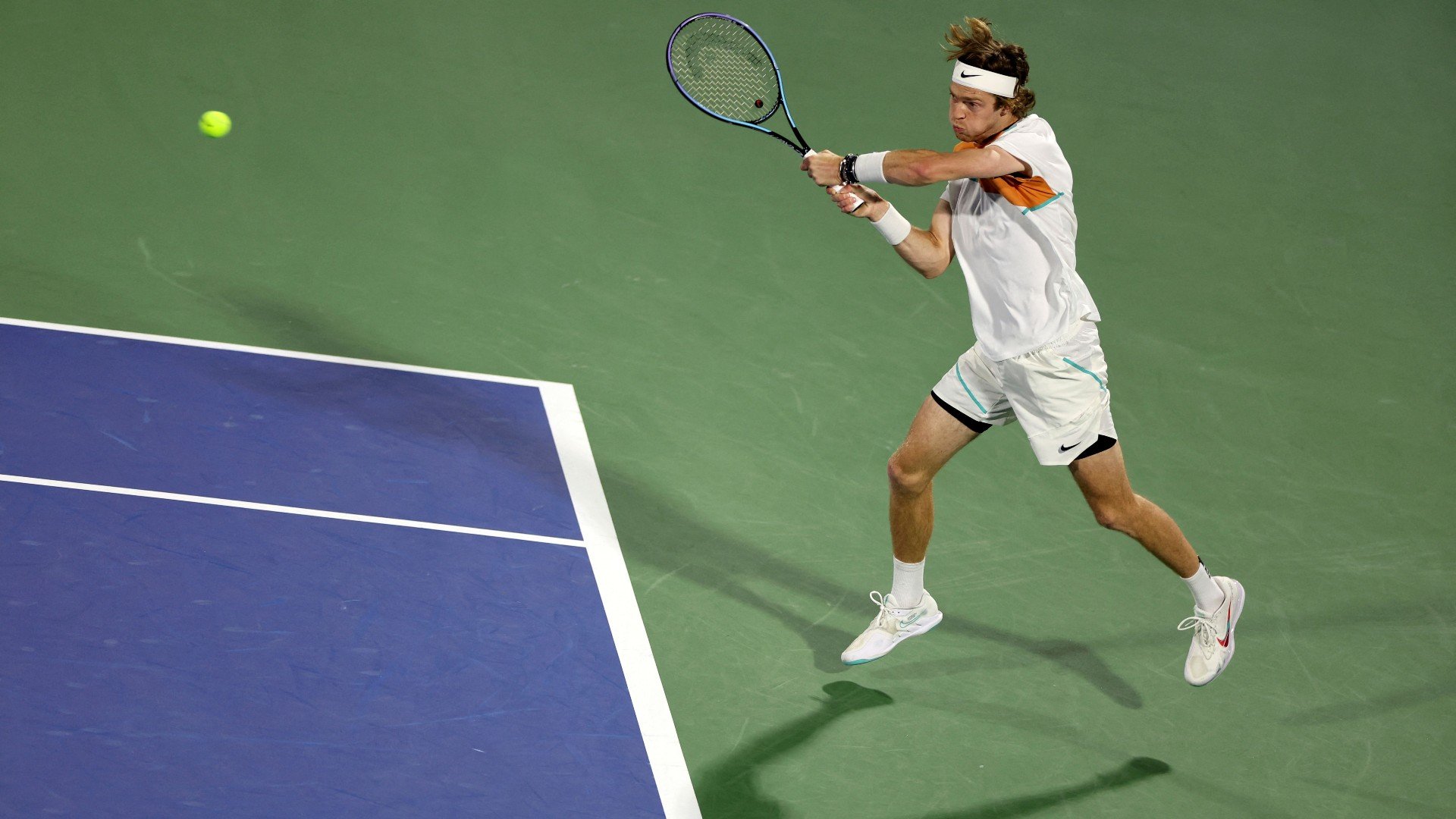What Makes Andrey Rublev One Of The Best Tennis Players In The World
Andrey Rublev is a professional tennis player from Russia. He is considered one of the best players in the world and has achieved a career-high ATP ranking of No. 5. He has won several ATP Tour singles titles and reached the finals of several major tournaments, including the US Open and the ATP Final. Rublev has won 12 ATP Tour singles titles to date.
Credit: Getty Images/Thomas Kronsteiner.
Racket Set-Up
According to ATPtour.com, Andrey is sponsored by Nike and HEAD. He endorses the HEAD Graphene 360+ Gravity Pro. Many professionals do not use the endorsed racket but rather they have their customised rackets with the exact paint jobs as the endorsed rackets.
Andrey’s racket specification:
Paint Job: Head Graphene 360+ Gravity Pro
Frame: Pro Stock Head Gravity Pro (TGT 344.4)
String Pattern 18 x 20
Head Size: 100 sq. in.
Strings: Head Lynx Tour at 25-26 kg (55-57 lbs)
Strung mass: 340g – 357g
Strung Balance: 32cm
Strung Weight: 335 Approx
Length: 27 inches
Andrey was a long-time Luxilon Adrenaline user before switching to the Head Lynx Tour. Both strings are similar in terms of feel and control. Thanks to his fast swing speed, he can easily generate power and spin with the stiffness of this racket.
Forehand
Rublev keeps his head still even after striking the ball.
Andrey Rublev's right-handed forehand is considered one of the most powerful and aggressive shots in professional tennis. He is known for his ability to generate a lot of spin and pace on his forehand, making it a difficult shot for opponents to handle.
Rublev's forehand is characterized by his compact, Eastern grip, which allows him to hit flat powerful shots. He also has a very high racket head speed and a strong shoulder turn, providing him even more power.
One of Rublev's key strengths on his forehand is his ability to dictate play from the baseline. He hits the forehand with a lot of pace and accuracy, making it difficult for opponents to hit good passing shots. Additionally, he often uses his forehand to hit winners or force errors from his opponents.
Here is a breakdown of his forehand:
Upon eyeing the ball, his left arm (non-hitting arm) is stretched out across his body, with most of his back towards his opponent.
Upon coiling his body, his racket head is closed and he keeps it on the hitting side of his body.
The tip of his racket is slightly higher than his head and his strings are tilted down, somewhat 45 degrees closed.
Once he pulls his racket back, he drops his racket heads slightly below the ball and accelerates through the ball.
His shoulders and hips uncoil during the follow-through, and he finishes with his body facing the net. He pays close attention to the ball when he strikes it and frequently makes early contact with the ball to take it from below the ball.
He ends the stroke with most of his weight transferred from his right foot to his left.
Andrey Rublev's forehand is considered one of the best in the game, thanks to his compact Eastern grip, high racket head speed, strong shoulder turn, consistent power, and his ability to dictate play from the baseline.
Backhand
Rublev’s arms are almost fully extended as he swings at the ball.
Andrey uses the double-handed backhand. He uses the continental grip on his bottom hand, whilst using the eastern grip on his top hand. Here is a breakdown of his backhand:
Following the split step, he executes a full unit turn as his grip on the racket shifts. This will leave him in either an open or closed stance.
Andrey prepares his backswing early and goes into the closed stance.
He puts his weight onto his back foot (left foot), and whilst in this position, both of his arms are slightly bent.
As he accelerates his racket, he transfers his weight from his back foot to his front foot. His left arm straightens to guide his racket forward.
As he swings, the full uncoiling process enables maximal acceleration and power. This permits him to add spin more easily to the ball and establish better control by making contact with the ball in front of his body.
Andrey finishes off the swing with the follow-through and brings his left leg forward to return to a neutral stance to aid in the recovery of his position.
Serve
Rublev drops his racket head low to give it more room to accelerate.
Here is the breakdown of his service motion:
Andrey starts with a platform stance, with his left foot pointing 45° towards the baseline. His body weight lies on the front foot during the start of the motion.
As he begins his toss, there is a weight transfer to his back foot
As the ball is tossed in the air, he starts to coil his right hand, like how athletes prepare to throw a javelin in the Olympics.
He relaxes his knees, curls his shoulders and hips, and then begin to press down on the ground like a spring.
After the coiling of the right hand is complete, Andrey goes in the trophy pose. At this point, his body weight has been transferred to his front feet.
He then begins to uncoil from the hips to launch towards the ball, pushing off the ground with his feet while his knees straighten and carry him into the air.
He stretches his arm out in front of him and pronates his wrist as the racket moves toward the ball. At the moment of impact, his arm will be completely extended.
Upon completing the serve, his momentum carries his body into the court. Right after landing on the court, he recovers back to a ready position awaiting the return from his opponent.
Return Of Serve
Rublev has super fast reflexes that makes him one of the best returners.
One of Andrey Rublev's most underrated talents is his outstanding ability to return first serves. According to an Infosys ATP Beyond The Numbers analysis of the eight players who competed in the Nitto ATP Finals, Rublev led all competitors when it comes to winning points on first-serve returns over 10 months in 2022. Compared to the other competitors, Rublev's first-serve returns proved quite impressive with a success rate of 51.7%. Only Novak Djokovic came close to matching that at 50.6%, making him the only other player who broke through the 50% threshold level.
Play Style
Andrey Rublev is known for his aggressive playing style and powerful groundstrokes. He possesses a big serve and a very heavy forehand, which he uses to dictate points. His backhand is also a strong shot, and he uses it effectively to hit winners or set up points.
Rublev's game is built around his ability to dictate play from the baseline, utilizing his powerful groundstrokes to put pressure on his opponents. He is also known for his consistent serve, which allows him to win a high percentage of service games. He is comfortable playing on all surfaces and has had success on hard courts, clay, and grass courts.
In addition to his strong technical skills, Rublev is also known for his mental toughness and competitive spirit. He can maintain his focus and intensity throughout matches, even in high-pressure situations. He is able to perform well under pressure and can turn the tide in matches.
Overall, Rublev's playing style is characterized by his aggressive and powerful baseline game, complemented by his solid net play and consistent serving. His ability to dictate play and hit winners with both his forehand and backhand makes him a formidable opponent on the tour. He has been praised for his consistency and ability to perform well on all surfaces. He is considered one of the top players on the ATP Tour and is seen as a potential future Grand Slam champion.






"The Philosophical Tennis Player: Thinking Your Way To Winning" offers a unique perspective on the sport of tennis. This book provides guidance inspired by philosophy to help you rethink the game and reach your peak performance. The author breathes life into abstract philosophical concepts, transforming them into tangible strategies everyone can use to become a successful player. Readers will gain insight into the psychological aspects of tennis and recognise the timeless values that extend beyond the confines of the court.
About The Author
Darren Teo is the founder of Play! Tennis, the most Google reviewed tennis academy in Singapore. His passion for making tennis accessible to everyone regardless of their age, experience and ability continues to drive his work at the school. He is a thought leader in LinkedIn with 14,000 followers.